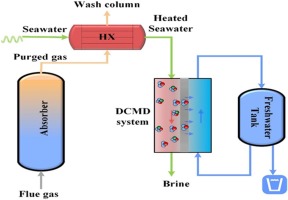International Journal of Greenhouse Gas Control ( IF 4.6 ) Pub Date : 2020-01-15 , DOI: 10.1016/j.ijggc.2020.102957 Asad Ullah , Mujeeb Iqbal Soomro , Woo-Seung Kim , Muhammad Wajid Saleem

|
In this study, direct contact membrane distillation (DCMD) technology was proposed to produce freshwater by utilizing the low-grade waste heat from the gases purged from the absorber of a CO2 capture unit. A Rate-based model has been used to simulate a monoethanolamine (MEA)-based CO2 capture process in Aspen Plus® V.10, and DCMD unit was simulated with the MATLAB software. The regeneration energy requirement in the CO2 capture process and freshwater production in DCMD unit were analyzed by varying the operating parameters. Cold seawater and purged gas were allowed to pass through the additional heat exchanger; as a result, the temperature of seawater increased. Then the warmed seawater was injected into the DCMD unit to produce freshwater. The freshwater production was 88,599 L/day at the feed temperature of 52.2 °C, which reduced to 85,050 L/day when the feed temperature declined to 50.3 °C. The freshwater production was 88,950 L/day at the permeate temperature of 10 °C, which declined to 78,450 L/day when the permeate temperature increased to 20 °C. Since adequate amount of freshwater was produced by the proposed system, the proposed integration method could help to mitigate environmental pollution and freshwater crises.
中文翻译:

使用膜蒸馏技术从CO 2捕集单元的吸收塔废气中回收废热,用于生产淡水
在这项研究中,提出了直接接触膜蒸馏(DCMD)技术,该技术通过利用从CO 2捕集单元的吸收塔中排出的气体中的低级废热来生产淡水。基于速率的模型已用于在AspenPlus®V.10中模拟基于单乙醇胺(MEA)的CO 2捕集过程,并使用MATLAB软件模拟了DCMD单元。CO 2中的再生能量需求通过改变运行参数来分析DCMD装置的捕集过程和淡水生产。允许冷海水和吹扫的气体通过附加的热交换器。结果,海水温度升高。然后,将温暖的海水注入DCMD装置以产生淡水。在进水温度为52.2°C时,淡水产量为88,599 L /天,当进水温度降至50.3°C时,淡水产量为85,050 L /天。在10°C的渗透温度下,淡水产量为88,950 L /天,当渗透温度升高至20°C时,淡水产量降至78,450 L /天。由于建议的系统产生了足够数量的淡水,因此建议的整合方法可以帮助减轻环境污染和淡水危机。











































 京公网安备 11010802027423号
京公网安备 11010802027423号